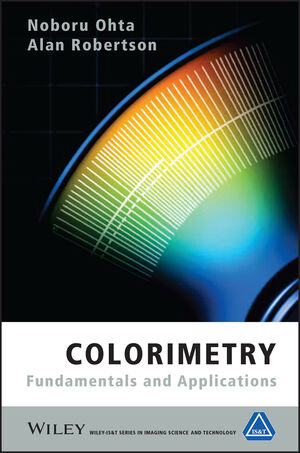Colorimetry: Fundamentals and ApplicationsISBN: 978-0-470-09472-3
Hardcover
350 pages
December 2005
 |
||||||
Series Preface.
Preface.
Introduction.
1 Light, Vision and Photometry.
1.1 Light.
1.2 Mechanism of the Human Eye.
1.3 Adaptation and Responsivity of the Human Eye.
1.4 Spectral Responsivity and the Standard Photometric Observer.
1.5 Definition of Photometric Quantities.
1.6 Photometric Units.
1.7 Calculation and Measurement of Photometric Quantities.
1.8 Relations Between Photometric Quantities.
Note 1.1 Luminous Exitance, Illuminance, and Luminance of a Perfect Diffusing Plane Light Source.
Note 1.2 Luminance and Brightness.
2 Color Vision and Color Specification Systems.
2.1 Mechanism of Color Vision.
2.2 Chemistry of Color Vision.
2.3 Color Specification and Terminology.
2.4 Munsell Color System.
2.5 Color System Using Additive Color Mixing.
Note 2.1 Colorfulness, Chroma and Saturation.
3 CIE Standard Colorimetric System.
3.1 RGB Color Specification System.
3.2 Conversion into XYZ Color Specification System.
3.3 X10Y10Z10 Color Specification System.
3.4 Tristimulus Values and Chromaticity Coordinates.
3.5 Metamerism.
3.6 Dominant Wavelength and Purity.
3.7 Color Temperature and Correlated Color Temperature.
3.8 Illuminants and Light Sources.
3.9 Standard and Supplementary Illuminants.
Note 3.1 Derivation of Color Matching Functions from Guild and Wright’s Results.
Note 3.2 Conversion between Color Specification Systems.
Note 3.3 Conversion into XYZ Color Specification System.
Note 3.4 Imaginary Colors [X] and [Z].
Note 3.5 Photometric Quantities in the X10Y10Z10 Color System.
Note 3.6 Origin of the Term ‘Metamerism’.
Note 3.7 Simple Methods for Obtaining Correlated Color Temperature.
Note 3.8 Color Temperature Conversion Filter.
Note 3.9 Spectral Distribution of Black-body Radiation.
4 Uniform Color Spaces.
4.1 Uniform Chromaticity Diagrams.
4.2 Uniform Lightness Scales (ULS).
4.3 CIE Uniform Color Spaces.
4.4 Correlates of Perceived Attributes.
4.5 Comparing CIELAB and CIELUV Color Spaces.
4.6 Conversion of Color Difference.
4.7 Color Difference Equations Based on CIELAB.
Note 4.1 Calculation of Munsell Value V from Luminous Reflectance Y.
Note 4.2 Modified CIELAB and CIELUV Equations for Dark Colors.
Note 4.3 Other Color Difference Formulas.
Note 4.4 Direct Calculation of Hue Difference δH*.
5 Measurement and Calculation of Colorimetric Values.
5.1 Direct Measurement of Tristimulus Values.
5.2 Spectral Colorimetry.
5.3 Geometrical Conditions for Measurement.
5.4 Calculation of Colorimetric Values.
5.5 Colorimetric Values in CIELAB and CIELUV Uniform Color Spaces.
Note 5.1 Spectral Colorimetry of Fluorescent Materials.
Note 5.2 Reference Standard for Reflection Measurements.
6 Evolution of CIE Standard Colorimetric System.
6.1 Additive Mixing.
6.2 Subtractive Mixing.
6.3 Maximum Value of Luminous Efficacy and Optimal Colors.
6.4 Chromatic Adaptation Process.
6.5 von Kries’ Predictive Equation for Chromatic Adaptation.
6.6 CIE Predictive Equations for Chromatic Adaptation.
6.7 Color Vision Models.
6.8 Color Appearance Models.
6.9 Analysis of Metamerism.
Note 6.1 Color Mixing Rule.
Note 6.2 Lambert–Beer Law.
Note 6.3 Method for Calculating the Maximum Value of the Luminous Efficacy of Radiation.
Note 6.4 Method for Calculating Optimal Colors.
Note 6.5 Method for Obtaining Fundamental Spectral Responsivities.
Note 6.6 Deducing von Kries’ Predictive Equation for Chromatic Adaptation.
Note 6.7 Application of von Kries’ Equation for Chromatic Adaptation.
Note 6.8 Application of CIE 1994 Chromatic Adaptation Transform.
Note 6.9 Theoretical Limits for Deviation from Metamerism.
7 Application of CIE Standard Colorimetric System.
7.1 Evaluation of the Color Rendering Properties of Light Sources.
7.2 Evaluation of the Spectral Distribution of Daylight Simulators.
7.3 Evaluation of Whiteness.
7.4 Evaluation of Degree of Metamerism for Change of Illuminant.
7.5 Evaluation of Degree of Metamerism for Change of Observer.
7.6 Designing Spectral Distributions of Illuminants.
7.7 Computer Color Matching.
Note 7.1 Computation Method for Prescribed Spectral Distributions.
Appendix I Basic Units and Terms.
AI.1 SI Units.
AI.2 Prefixes for SI Units.
AI.3 Fundamental Constants.
AI.4 Greek Letters.
Appendix II Matrix Algebra.
AII.1 Addition and Subtraction of Matrices.
AII.2 Multiplication of Matrices.
AII.3 Inverse Matrix.
AII.4 Transpose Matrix.
Appendix III Partial Derivatives.
Appendix IV Tables.
References.
Bibliography.
Index.



